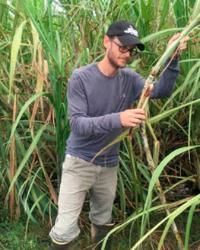Anna Mészáros of the UF/IFAS Palm Beach County Extension office and Dr. Julien Beuzelin of the UF/IFAS Everglades Research and Education Center recently began investigating the increase in unusual insect injury observed since 2020 in conventional and organic celery and parsley fields in southern Florida. This injury consisted of weevil larval tunneling through plant petioles, crowns, and roots. A research and extension program was initiated to identify the insect causing the injury, study pest population dynamics, evaluate insecticide efficacy, and promote information exchange to answer grower needs.
- The weevil adults infesting celery plants were identified as Listronotus sparsus, a relatively widespread species that was not previously reported as a crop pest.
- This weevil exhibits behavior comparable to carrot weevils, L. oregonensis and L. texanus, which are serious pests of Apiaceae crops in the Great Lakes region and Texas, respectively. Thus, this weevil might represent a significant threat to celery, parsley, dill, cilantro, and carrot production in Florida.
- In celery, most of the weevil damage is at the base of the petioles, especially in the outer petioles; tunnels can be as long as four inches from the base of the plant going up through the petiole. Weevils can also feed on the crowns of celery plants. In parsley plants the petioles are thinner than in celery plants, therefore weevils tend to feed more on the base of the plant and the roots.
- Observations suggest that the weevil infests plants throughout the crop season and has multiple overlapping generations per year.
- Based on grower commercial practices and our experiments, Vydate is currently recommended for weevil management in celery, however, this insecticide is not registered for use in parsley. Exirel and Diamond might have activity against the weevil. However, while Exirel is registered for use on celery and parsley, Diamond is not registered on either crop. Thus, there is a need for additional studies evaluating insecticides, including Exirel and Diamond, which showed promising results in Canada for L. oregonensis control. These studies might lead to new insecticide registrations and updated L. sparsus management recommendations.
We are thankful for our great collaborations with Florida celery and parsley growers and crop consultants who have shared their knowledge and have assisted with on-farm experiments to develop a management solution for L. sparsus.
If you suspect an L. sparsus infestation in your field, please contact Julien Beuzelin, jbeuzelin@ufl.edu, or Anna Meszaros, ameszaros@ufl.edu.
For more information on L. sparsus, including details on feeding symptoms and management research, visit this page.
|

|
| Listronotus sparsus adults |
|

|
| Larva at the base of a celery petiole |
Read Past Research Connections Articles



